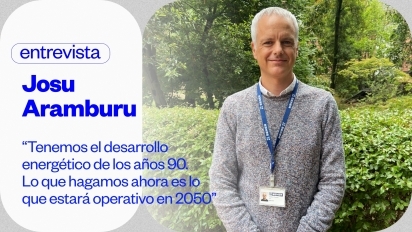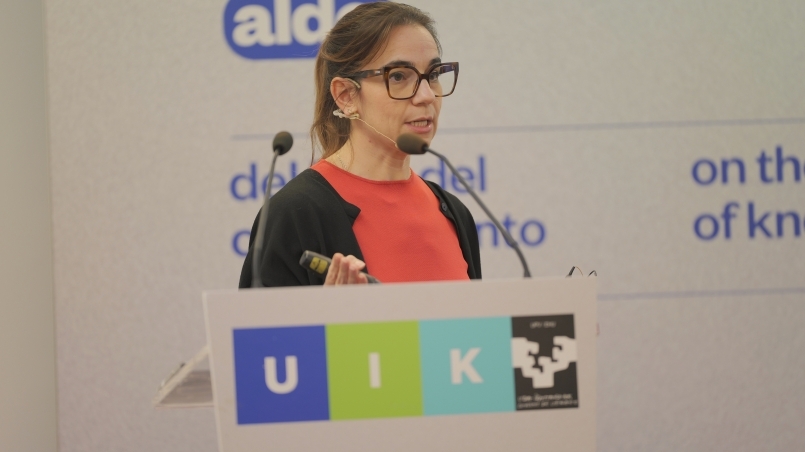We have the energy development of the 1990s, whatever we do now is what will be operational in 2050
In the summer of 2020, in the midst of the pandemic, the EU set out a strategy for the use of hydrogen in a climate-clean and emission-free Europe by 2050, making it one of the key vectors. The goals set were 6 GW installed by 2024, 40 by 2030 and by 2050 to move from 2% to 14-15% of the EU's energy use. A minimum investment of 180,000 million euros is considered, which could reach up to 470,000 million Euros.

Data provided by Josu Aramburu, head of sustainability at SENER, in the course "Sustainability, SMEs and financing" organised by Elkargi.
It must be taken into account that the useful life of the solutions that are designed in terms of renewable energy is 25 years old, so "what we do in the next few years is what will be operational in 2050 and has to replace all the energies that we have been developing since the 1990s".
How we act now is very important. European plans consider a first phase between 2020-2025 with the installation of 6 GW; the focus is on introducing hydrogen locally in those locations where hydrogen is already being consumed (as in the case of Petronor in the Basque Country, which consumes grey hydrogen from fossil fuels), and also applying it in the mobility sector, starting with vehicle fleets, most logically in buses and trucks with hydrogen cells. This logically requires a development in the installation of hydrogen plants in the territory.
In a second phase, from 2030 onwards, the stakes are already very high: 40GW of electrolysers. This means that new uses for hydrogen must be sought. Reaching out to energy-intensive industries to help them develop the technologies that will enable them to use hydrogen as a fuel. Industries that need to do pre-testing, process modifications, etc. to prepare for when H2 arrives on their doorstep.
Hydrogen Valleys are geographically born in places where demand for hydrogen can be accumulated and supplied in small distribution networks. These valleys are emerging in Asturias, the Basque Country, Navarra, Aragon and Catalonia for a more ambitious development focused not on the current consumer but on the future one.
The Basque hydrogen runner is studied not only for production and consumption solutions. It is a commitment to technology development. Josu Aramburu recalls that "In order to feed the 40GW of electrolysers, between 80 and 120 GW of solar and wind energy are needed to obtain green hydrogen, in other words, the renewable energy vector needs to be developed; to attract new hydrogen consumers, the technology to be applied to mobility needs to be developed and industry needs to be provided with the technological development it will need in its facilities to be hydrogen consumers".
In addition to urban uses, he is also considering synthetic fuels obtained from the absorption of CO2 by applying hydrogen to obtain paraffin, methanol or biodiesel, which provide a solution for mobility that is difficult to electrify, such as aircraft or ships.
Josu Aramburu provides a very significant fact in the current scenario. "If we are talking about 40GW in 2030, the EU currently has the capacity to generate 1 GW per year". We must also think about the electrolyser production industry (which we do not yet have in the Basque Country and few in Europe), the auxiliary industry of purification, filtering, compression, dispensing, etc. In short, a whole world of technology to be developed, already contemplated in the strategy, in order to reach the goals, set for 2030.
Josu Aramburu is convinced that in 2050 there will be technological solutions for hydrogen production that are still being researched in the laboratory, obtaining hydrogen from waste, using waste water or using environmentally friendly energy sources that are more efficient than the current ones... all of which will contribute to reducing H2 generation costs while ensuring the sustainability of our solutions. A fundamental matter because compared to green hydrogen, grey hydrogen or natural gas is still much cheaper.
Facing fears of possible negative interference from the Ukraine war in this journey, Josu Aramburu remains optimistic given that this past May 2022 the EU approved the REPowerEU Plan (Plan to end the EU's dependence on fossil fuels) which talks about accelerating hydrogen and accelerating bio methane targets. Relying again on coal to curb energy independence as Germany is suggesting is one option. Bad for emissions, but industry will not be able to replace natural gas with coal. "In this regard, the EU stresses the need to accelerate energy decarbonisation solutions that allow us to gradually replace natural gas with solutions that involve electrification and hydrogen. Moreover, the path mapped out for 2025 and 2030 and beyond will be accelerated. Natural gas will be replaced sooner.
We are at a moment of opportunity and risk for energy companies, natural gas companies, petrochemical companies... opportunity because there will be new solutions to develop, and risk for companies that intend to continue doing things as they have been doing up to now without adapting. "The broad concept of sustainability includes sustainability over time". For a company to be able to last the must be open to the changes that are taking place. "It is true that the law is going to force us, but it is true that this change is something that is going to happen. If you want to move forward, you have to be in it".
The European taxonomy, lately criticised for including natural gas and atomic energy as valid in the energy transition on a temporary basis to ensure a price limit in the current situation, does not cease to set the guidelines for financing the energy market towards green energy and not to other energies. "Transitorily there will be solutions based on CO2 capture, electrolysis using natural gas, but the end is renewable hydrogen".


